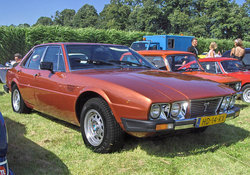Difference between revisions of "De Tomaso Deauville"
m |
m |
||
| Line 63: | Line 63: | ||
| + | ==Gallery== | ||
<gallery> | <gallery> | ||
Revision as of 09:38, 26 May 2009

| |
| De Tomaso Deauville | |
|---|---|
| Manufacturer | De Tomaso |
| Production | 1971–1985 |
| Class | |
| Body style | 4-door sedan |
| Engine | V8 |
| Transmission | Ford C6 3-speed automatic |
| Layout | FR layout |
| Wheelbase | 2770 mm (109.1 in) |
| Length | 4851 mm (191 in) |
| Width | 1880 mm (74 in) |
| Height | 1372 mm (54 in) |
| Weight | 1940 kg (4273.1 lb) |
| Similar | |
| Fuel capacity | 2 x 60 litres (120.5 litre, 26.5 Imp gal, 31.8 US gal) |
| Designer | Tom Tjaarda under Ghia |
Overview
Alejandro de Tomaso frequently used the good ideas of other people for his own conceptions. A classical example of it is the Deauville, which appeared 1971. The technology of the car was typical for De Tomaso, but the body was an accurate reproduction of the new Jaguar XJ6 sedan. The wheel base was shorter but had a wider track. The car, overall, was 20 cm shorter and allegedly 160 kg lighter. De Tomaso wanted XJ6 alternative of its own, with the glamour of an exotic name but with less complicated technology. Therefore he inserted the Ford V8 motor from the Pantera and equipped it exclusively with Ford's C6 mechanicals. Ghia had sketched a stable, self-supporting body, which was equipped all around with double wishbones and independent suspensions. It was to be a beautiful, fast and elegant car with excellent handling characteristics, yet it sold badly. De Tomaso had never developed the right dealer network outside of America and the Deauville was not even offered in that market. As was the case with Iso, with whom De Tomaso competed fiercely at the beginning of the 70's, the sound (plus the well-known "across-the-pond" origin of the Ford V8) spoke against the Deauville. Compared with Ferrari and Lamborghini neither sound nor a character were correct. The result was finally a maximum annual sales rate of 46 units (1972). By the end of the decade, only 208 copies had been sold. Nevertheless, the Deauville was still available by 1988. Officially, the 270 hp example, sold only 241 copies. In reality only the strongest engines were selected, in order to move a nearly 2-ton sedan with reasonable performance. In 1978, the entire chassis was revised and used concurrently with the new Maserati Quattroporte. The Deauville ceased production in 1988.
History
De Tomaso Deauville is a large four door sedan exhibited at Turin Motor Show 1970. The car featured 351 in³ (5763 cc) Ford Cleveland V8, same as used in De Tomaso Pantera. With 330 horsepower (some later stage 270 hp) the car could reach top speed of 230km/h. The car could be seen as competitor to the Jaguar XJ. Although Alejandro de Tomaso took a good look at the Jaguar XJ, the Deauville was much more modern in terms of styling (comparable to the much later 90's XJ40 cars) and more sports car like.
The Deauville had independent suspension both front and rear and ventilated discs all round. The Maserati Quattroporte III was developed on the exact same chassis, both cars share e.g. suspension, shocks and differential.
Total production was 244
There were roughly 3 types of the Deauville: the early series 1 (from 1970 until 1974: serial number 10##, 11## and 12##), late serie 1 (1975 until 1977: serial numbers 14##) and the series 2 (1978 until 1985: serial numbers 20## and 21##). The differences between series 1 and 2 are minor. On technical level the engine was placed 10 centimeter towards the passenger cabine (for better weight balance), the rack-and-pinion steering was replaced with a ZF power steering and there were air louvres in both sides of the car. The rest of the changes were mainly cosmetical: interior, bumpers, placement of the scripts at back and front.
Only one station wagon was made for Mr. De Tomaso's wife. There were also a couple of amoured Deauvilles produced for the Belgian Royal Family and for the Italian government and police. One of these cars is displayed in the Museo delle Auto della Polizia Di Stato in Rome
Trivia
Trivia 1: the Dutch importer Hessing sold a staggering 39 new cars in the Netherlands, that's almost 16% of the total production! Not bad for such a small country. Most of these cars are still somewhere in a garage, driving in Holland or were exported.
Trivia 2: The serial number 1040 Deauville was used in the Dutch Movie "Baantjer - Moord in Extase" as the bad villain's car. At the end of the movie the car is flipped onto its roof and completely wrecked.
Gallery
De Tomaso Modena S.p.A. car timeline, 1960s–2010s
| ||||||||||||||||||||||||||||||||||||||||||||||||||||||||||||||||||||||||||||||||||||||||||||||||||||||||||||||||||||||||||||||||||||||||||||||||||||||||||||||||||||||||||||||||||||||||||||||||||||||||||||||||||||||||||||||||||||||||||||||||||||||||||||||||||||||||||||||||||

